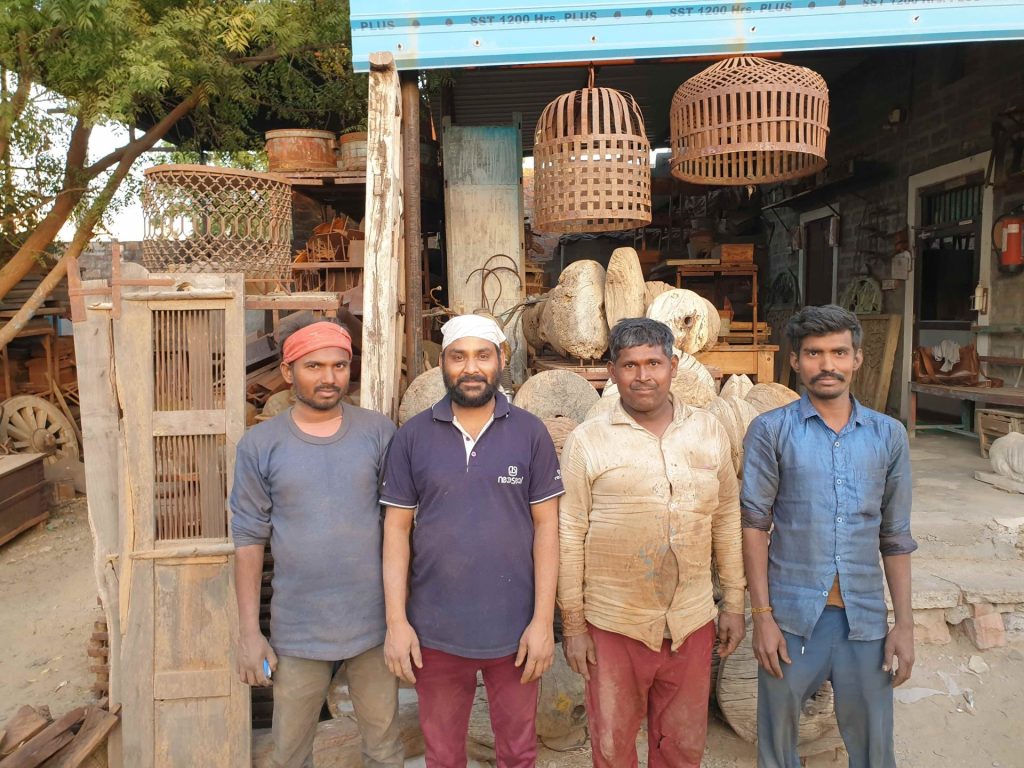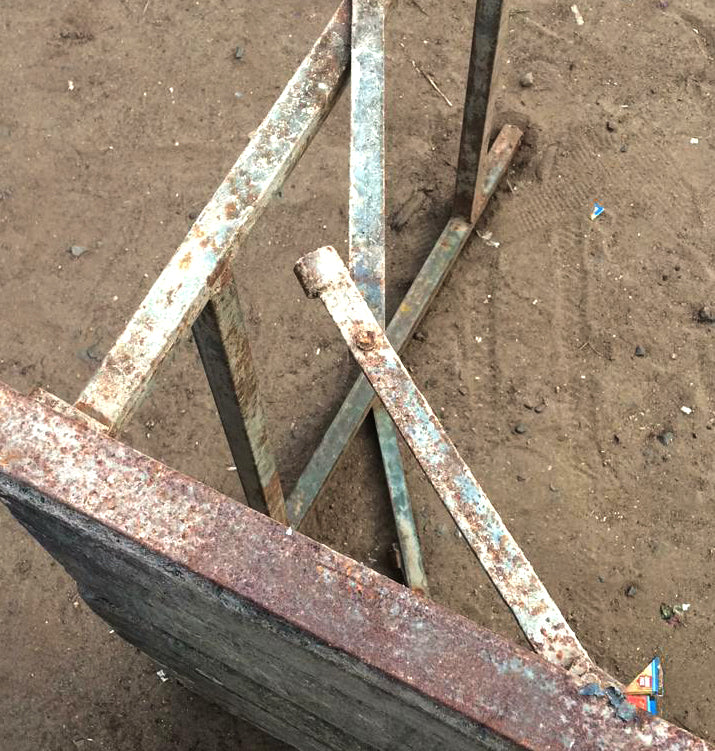"How to: Restore a Vintage Table" is part of a series of step-by-step guides showing how we bring our furniture back to life without losing original character and charm.
We started buying these old, vintage tables about 10 years ago. We started out with just 10 pieces, but this year alone we're on track to buy and sell over 400! They're incredibly flexible and versatile, and have each undertaken a long and comprehensive restoration process to ensure their functionality for another 30 years. Read on to learn a little about their history, how they are restored and how they can be used around your home.


They're very strong and sturdy, incredibly flexible, versatile and can be set up in seconds. This style of vintage table usually has an iron frame and legs. A top or legs and top made from tropical hardwood. Other styles include wooden legs and top. They're built more for function than good looks, but because they have been used so man times, they develop a unique character of their own. They've usually been painted several times and older layers of paint and the dark hardwood are often exposed. The big domed bolts and washers used to secure the wooden tops and tubular steel frame give this vintage table an industrial look and feel.

Vintage Table History
Originally these vintage table's are used as wedding guest dining tables. An Indian wedding will often have more than 500 and sometimes 2,000 guests, who over several days are treated to an amazing feast of Indian curries and traditional dishes as they celebrate the bride and grooms nuptials. These tables are usually covered with a decorative table cloth and then seat 4-6 guests.
Often called 'tent tables' across northwestern India, they are used repeatedly during the Indian wedding seasons. Traditionally Rajasthani weddings would have been held in brightly decorated decorated tents - to keep the desert dust and searing sun off the guests. The Indian bride, groom and their parents will look for auspicious dates in the Hindu calendar. January, February and May are usually the months with the most dates, which means in Rajasthan larger cities like Jodhpur, Jaipur and Udaipur will see hundreds of weddings taking place on the same days.

We buy them their original very well used condition and spend around 2-4 hours restoring each table. Each batch of tables is different. A batch could number 10 or 150. Over the years the are hired out for wedding events they really do take on their own character. They will be painted and repainted every few years, over time the older layers of paint make come through. The wedding hire table owners will add their name and contact details on the tables. Some will need minimal restoration work and other substantial work to bring them back to life. We aim to retain their original patina and character. So we don't strip off the old paint, sand down uneven edges or even fill the gaps between the planks.

Restoring A Vintage Table
Here is a step by step guide to how expert blacksmiths and carpenters restore old wooden tables. Below you will see how we buy the tables: rusty, damaged and in need of some serious expert restoration. Sometimes we need to repair damaged wood. We took one table and spent 4 hours painstakingly restoring it. It gets taken from a rusty grubby table to a piece that's going last for at least another 20 years.
 This is a metal-framed table with a wooden top in it's 'found' condition
This is a metal-framed table with a wooden top in it's 'found' condition
 Rusted iron table as we find them in Rajasthan, India
Rusted iron table as we find them in Rajasthan, India
 This is how many of our tables look before we start the restoration. You might be able to see bad / perished wood along the edge that will need to be replaced
This is how many of our tables look before we start the restoration. You might be able to see bad / perished wood along the edge that will need to be replacedSmaller damaged wooden sections are cut out and a similarly sized and coloured replacement is added. Sometimes an entire length of a plank needs to be replaced using old parts of other tables. Of course it's not a perfect replacement, but that's how the tables would have been maintained during their life and in no time at all with use and wear and the replacement section will blend into the rest of the table. Where there's significant corrosion we'll remove the worst with sandpaper.
 We have removed the top because the frame was damaged and the left edge needs to be removed and replaced with reclaimed wood.
We have removed the top because the frame was damaged and the left edge needs to be removed and replaced with reclaimed wood.Often we'll remove all the wooden panels and Sankar, who comes from a long line of traditional Rajasthani blacksmiths, will repair the frame and legs which can become twisted and the folding legs may be wobbly. Where we've removed the top to repair the frame, we'll check the wood before we replace the top. We use bolts and nuts to secure the top. The wood used for the tabletops is

 Our carpenter has replaced the perished wood with reclaimed wood and is sanding it down
Our carpenter has replaced the perished wood with reclaimed wood and is sanding it down
 Rajasthani blacksmith Sankar reattached the tabletop to the frame
Rajasthani blacksmith Sankar reattached the tabletop to the frame
 Chunky bolts are used to attach the repaired top to the repaired iron frame
Chunky bolts are used to attach the repaired top to the repaired iron frame
 The top is now been secured to the frame
The top is now been secured to the frame
 Years and years of use have given the top an original time-worn finish.
Years and years of use have given the top an original time-worn finish.
 The final stage is to sand the top and the frame to remove rust and give a smoother surface. Then use a polish to nourish the old wood
The final stage is to sand the top and the frame to remove rust and give a smoother surface. Then use a polish to nourish the old woodThe penultimate stage involves washing the tables to remove dirt and grime. We finish off with a few drops of oil for the folding legs' joints and several layers of polish to nourish and revive the old wood and prevent corrosion. Our vintage metal tables are now ready.
 Once finished our tables retain their original old and well-used character
Once finished our tables retain their original old and well-used characterWhere To Use An Old Tables
The folding tables can be used as an industrial style dining table, office desks (Carl has one in his office), outdoors / /patio dining table, a large number of them can be lowered to a height that allows them to be used by wedding guests sitting crossed legged, making them perfect as coffee tables too. Being folding tables means they are very useful where space might be a challenge.
For an eclectic look pair the table with mismatched dining chairs - mid century, vintage and antique chairs in different colours. For an industrial style try Remploy plywood chairs or Tolix style chairs. WE thnk any atyle would work with these tables.
Old tables can be used as a desk for working at home or in an industrial influenced office. They can be easily moved. No toolbox and complicated instructions needed. Of course, they are at home in a kitchen or dining room. See Scaramanga's full range of old and vintage dining tables we have many in stock.
Answers on restoring a vintage table.
-
What are the initial steps to take before starting the restoration of a vintage table?
- Before beginning the restoration, it's crucial to assess the condition of the table. Check for any loose parts or damage. Cleaning the table with a mild cleaner is recommended to remove dirt and old wax. It's also a good idea to decide whether you want to preserve the patina or refinish the table entirely.
-
What materials will I need for the restoration process?
- You will need a few basic supplies including fine-grit sandpaper, wood cleaner, soft cloths, wood glue for any loose joints, and a suitable wood finish or varnish. For tables with more significant damage, you might also consider wood filler or replacement pieces that match the original wood.
-
How can I protect the table after restoration?
- After restoration, applying a protective finish like beeswax or a furniture sealant can help preserve the wood and enhance its appearance. It’s also good practice to keep the table away from direct sunlight and to clean it regularly with a soft, dry cloth to prevent dust buildup.






















